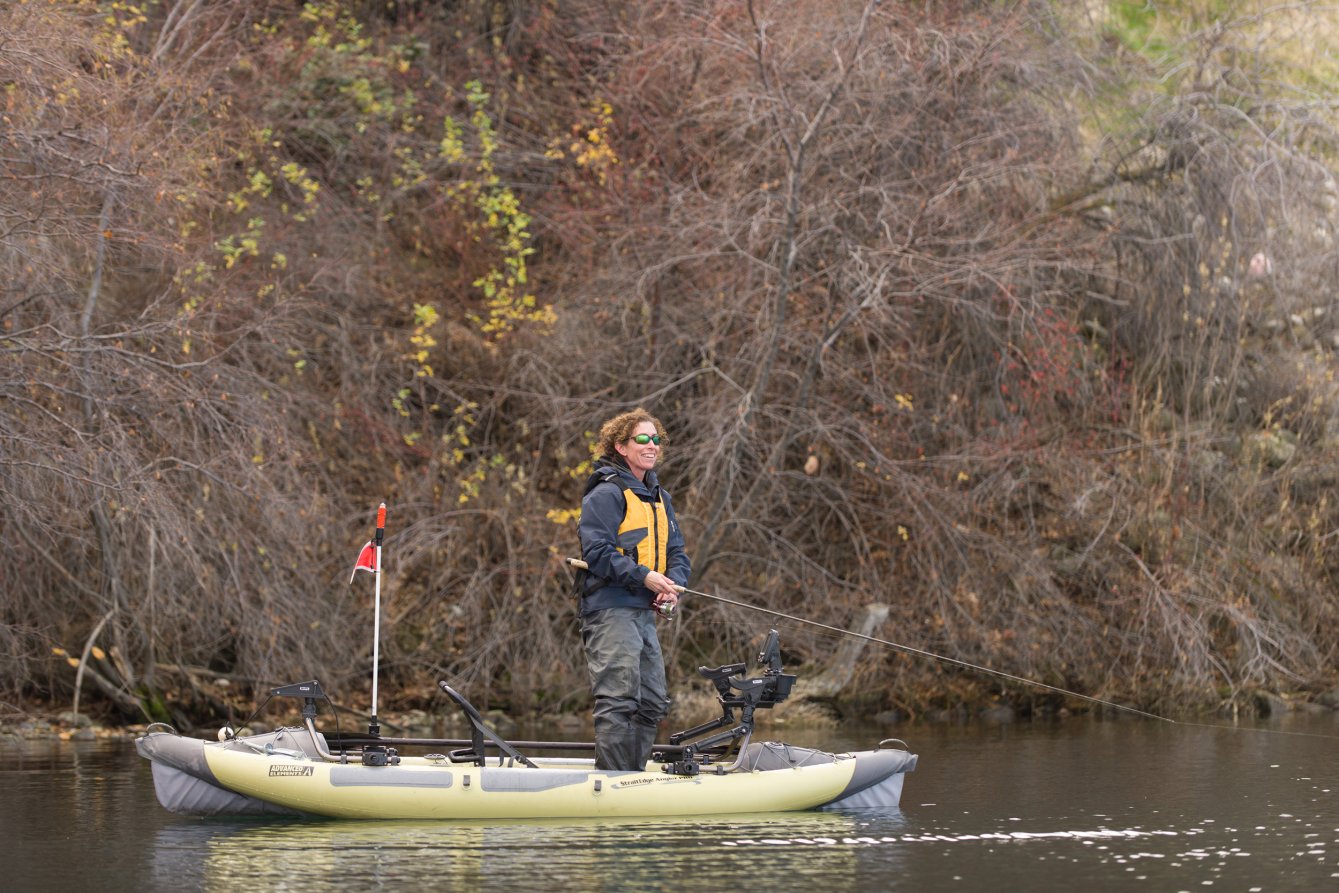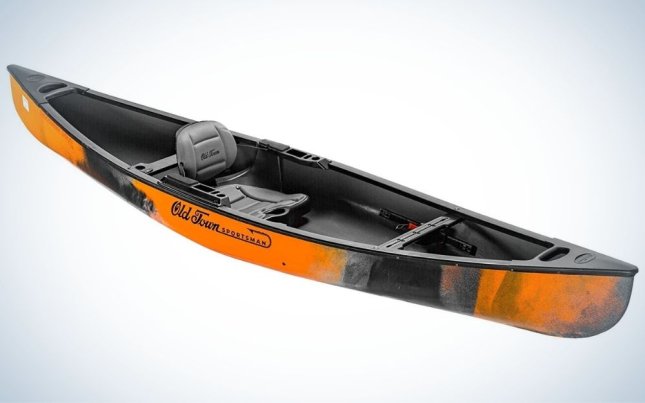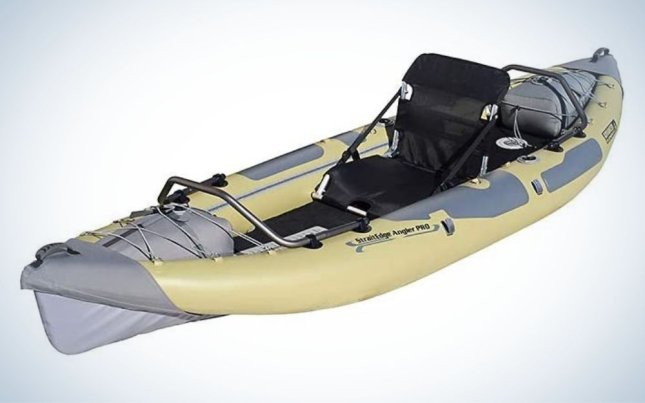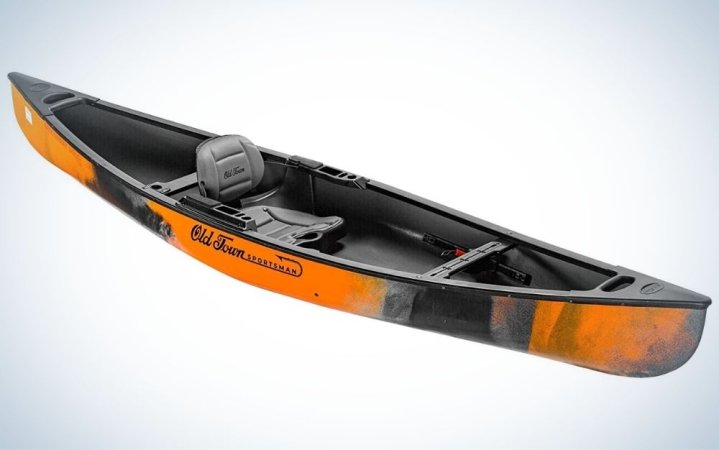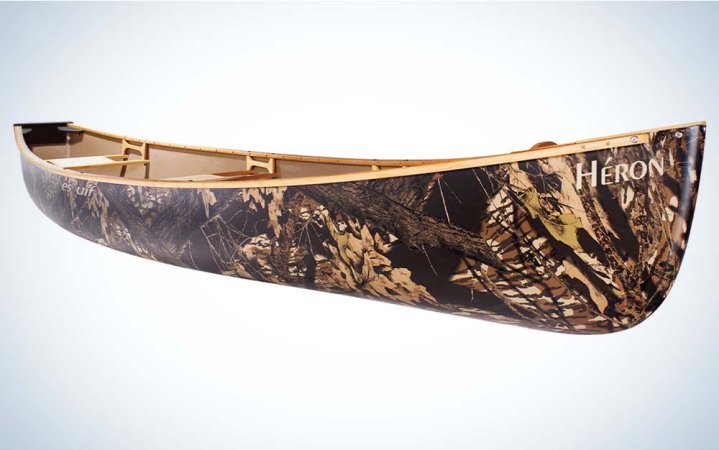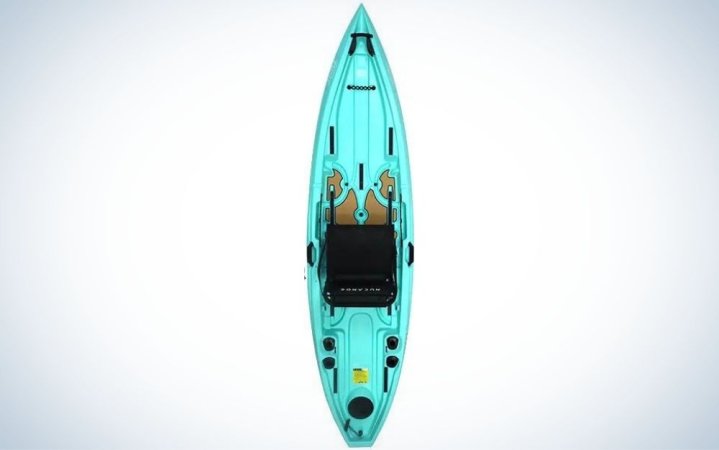We may earn revenue from the products available on this page and participate in affiliate programs. Learn More ›
Canoes have probably carried more people to more places than any other paddlecraft. Weekend paddlers and backcountry adventurers appreciate the canoe’s high capacity, low weight, and shallow draft. While canoes are great for carrying a ton of gear and a couple friends, they usually lack fishing features. However, manufacturers have developed fishing canoes with rod holders, gear tracks, and greater stability to make purpose-built fishing canoes. To make finding one easier, I tested the best fishing canoes on the market that should fit your fishing style and needs.
- Best Overall: Old Town Sportsman Discovery Solo
- Best Inflatable: Advanced Elements StraightEdge Angler Pro
- Best Square Stern: Esquif Heron
- Best for Standing: NuCanoe Flint
- Best Budget: Lifetime Wasatch
Things to Consider Before Buying a Fishing Canoe
According to Webster’s dictionary, a canoe is, “a light, narrow boat with both ends sharpened that is usually propelled by a paddle.” Canoes come in many sizes and styles, so it helps to recall the basic elements all canoes have in common. There are canoes for long distances, canoes for after-work getaways, and with paddle fishing’s growth in popularity, there are now great canoes for fishing.
Fishing canoes aren’t as popular as sit-on-top kayaks, but anglers looking to pack camping gear, load the family, and paddle backwaters will find that a canoe has more capability when it comes to these criteria. Regardless of your fishing endeavors, you’ll want to consider these factors below to choose the best fishing canoes for your needs.
Stability
Stability is the most important quality in a canoe for fishing. A wider canoe with a flatter bottom is more difficult to tip over. Also, moving the seat lower in the boat improves stability when you’re paddling or trolling.
Capacity
With a wide-open deck from stern to bow, a canoe has plenty of space to store tackle, hunting gear, or camping equipment. This design also increases capacity, so a canoe can carry more weight than a rotomolded kayak. Add a second seat, and a canoe has room for another angler, a couple kids, or a pet.
Weight
A canoe’s biggest advantage is minimal weight. Canoes use less material than most sit-on-top fishing kayaks, making them lighter without sacrificing storage capacity. Not only does the light weight make transporting the canoe easier, it’s also possible to carry one overland to reach distant fishing holes.
Durability
Most fishing kayaks are made of rotomolded or thermoformed plastic. These materials are tough but not as durable as the advanced materials used to make a canoe. The best fishing canoes are constructed of multi-layer plastic and composite materials that are almost impossible to damage and easy to repair.
Accessories
Canoes for fishing come with accessories to make rigging easy. Wider twarts and gunnels allow the angler to install rod holders. Look for space behind the seat to add a gear crate with vertical rod holders.
Best Overall: Old Town Sportsman Discovery Solo
Best Fishing Canoe Overall
Pros
- Comfortable seat
- Rod holders
- Gear tracks
Cons
- Only available in single-seat model
Key Features
- Weight: 56 pounds
- Dimensions: 11-feet, 9-inches long x 32.5-inches wide
- Materials: Three-layer polyethylene
Why It Made the Cut
The Old Town Sportsman Discovery Solo has everything you want in a fishing canoe: lightweight, high-capacity storage, it’s easy to paddle, and is ready to fish.
Product Description
A hybrid between a canoe and a kayak, the Old Town Sportsman Discovery Solo has the best features of both platforms. From the canoe side of the family, the Discovery Solo has an open cockpit, 56-pound weight, and 354-pound capacity. On the kayak side, the Discovery Solo has a single seat and foot braces to paddle with a double-blade kayak paddle.
To improve stability, the Discovery Solo has a concave hull that pushes volume to the outside while maintaining straight-line paddling performance. Because of this design, you can easily stand and fish in the Discovery Solo. Under the seat, there’s room to store a tackle tray, and rod holders behind the seat are angled for trolling or rod storage. Gear tracks offer an easy place to add elevated rod holders or electronics and accessories. The short waterline and low weight make the Discovery Solo great for quick trips to hard-to-reach fishing areas. I can throw the boat over my shoulder, grab a paddle and fishing rod, and hike a short distance to the water. In addition to easy trips, I like to load the Discovery Solo with camping, fishing, and hunting equipment for longer adventures.
Read Next: Best Fishing Kayaks Under $1,000
Best Inflatable: Advanced Elements StraightEdge Angler Pro
Best Inflatable Canoe for Fishing
Pros
- Packs into a carry case
- Drop stitch floors
- Multiple air chambers
- Aluminum accessory mounts and hull inserts
Cons
- Too small for long-distance paddling
Key Features
- Weight: 45 pounds
- Dimensions: 10-feet, 6-inches long X 38.5-inches wide
- Materials: Multi-layer PVC
Why It Made the Cut
The Advanced Elements StraightEdge Angler Pro combines great performance, solid construction, and smart fishing features. And the inflatable design and carrying case make it easy to pack or transport.
Product Description
I’ve tested tons of inflatable canoes, kayaks, and standup paddleboards, and the biggest factor that affects performance is rigidity. The StraightEdge Angler Pro uses three air chambers to increase rigidity. Two low-pressure air chambers create the gunnels and a third, drop-stitch panel creates the floor. Drop stitch chambers allow the user to inflate the panel to a higher air pressure and further increase stiffness. The aluminum frame also increases the canoe’s rigidity, and the bars offer space to mount rod holders, electronics, and other accessories. This sturdy platform also incorporates a comfortable frame seat that sits a few inches off the deck and has a high back to provide plenty of support.
Inflatable kayaks are so tough they’re popular for bouncing down rocky rivers. The StraightEdge Angler Pro uses puncture- and tear-resistant PVC material that’s reinforced at high-impact areas, so you can be confident on the roughest and rockiest waters. One of the biggest upsides to inflatable canoes is their packability. This small boat packs into a duffle bag that’s easy to roll or carry. It’s one of the few boats I’ve tested that easily goes in and out of the carrying case. I like to take the StraightEdge Angler Pro on vacation. And if you want to take the boat to distant fishing destinations, you can easily check the packed canoe as luggage.
Best Square Stern: Esquif Heron
Best Square Stern Canoe
Pros
- Room for three
- Cool webbed seats
- Available with Ash wood gunnels
Cons
- Expensive
Key Features
- Weight: 69 pounds
- Dimensions: 14-feet, 6-inches long X 38.5-inches wide
- Materials: T-Formex
Why It Made the Cut
Incredible capacity, durable construction, and the option to use an outboard motor make the Esquif Heron the best square-stern canoe.
Product Description
You can paddle square stern or power it with a small outboard motor. Esquif’s Heron is a high-quality canoe with the capacity of a skiff. At 14-feet, 6-inches long, the Heron has room for three anglers. And with an 800-pound capacity, there’s also space for tackle, camping gear, and hunting equipment. Classic webbed seats provide comfort for all day paddling, while the center yoke seat makes it possible to carry the Heron solo. I’m a big fan of Esquif’s T-Formex premium material that uses two layers of indestructible plastic and a foam core that’s light and insulates from the cold.
Paddle the Heron like a canoe to reach hidden fishing locations or throw on a three-horsepower gas or electric motor and zoom to distant destinations. For me, the Heron is a great family boat. On Saturdays, I rig the Heron with a small outboard and load the boat with gear and a buddy for fishing or hunting. On Sunday afternoons, I grab a couple paddles and the family and head out to explore a local lake. The boat is big enough to qualify as a skiff, but light enough to load into my pick-up truck bed.
Best for Standing: NuCanoe Flint
Best Standup Fishing Canoe
Pros
- Rotomolded plastic
- Easy to rig
- Elevated seat
Cons
- Heavy
Key Features
- Weight: 63 pounds
- Dimensions: 11-feet, three inches long X 33 inches wide
- Materials: Rotomolded plastic
Why It Made the Cut
The NuCanoe Flint is a kayak and canoe hybrid with a wide-beam and flat deck that has great stability for standup fishing.
Product Description
Like the name, NuCanoe is a new type of canoe. This hybrid canoe combines the best of both words with canoe-like capacity and the stability and performance of a kayak. It’s easy to paddle with a double-blade kayak paddle, and like a sit-on-top kayak, the Flint has an elevated frame seat that’s comfortable and convenient for standup fishing or sit-down paddling. A wide, flat hull provides stability, while the open deck with EVA foam padding offers plenty of room for standing and fishing.
The Flint’s biggest advantage is a ton of open space and gear tracks for mounting accessories like rod holders and electronics. Once I’m at my fishing spot, it’s easy to stand and fish on the wide, flat deck without any accessories or features in my way. Like a canoe, the cockpit is open from bow to stern. You can rig the flint with a full array of accessories, but I keep it simple with a tackle crate and vertical rod holders then a couple elevated rod holders attached to gear tracks on the gunnel.
Best Budget: Lifetime Wasatch
Best Budget Fishing Canoe
Pros
- Rod holders
- Removable seat backs
- Includes motor mount
Cons
- Heavy
Key Features
- Weight: 96 pounds
- Dimensions: 13 feet long X 39 inches wide
- Materials: Blow molded polyethylene
Why It Made the Cut
The Lifetime Wasatch canoe boasts a long list of features at a great price.
Product Description
If you’re looking to take the family fishing on the weekends and then sneak out for a quick paddle during the week, the Lifetime Wasatch is a perfect balance between family fun and solo fishing without breaking the bank.
With three seats, the Wasatch has room for your spouse and kids, and at only 13 feet long, the boat is easy for a single paddler to handle. The blow-molded plastic hull keeps the price down but doesn’t sacrifice durability. Its plastic hull is hard to damage and easy to fix. A wide, flat bottom keeps the boat stable, while the pronounced keel helps with straightline tracking. Cool features include a small wheel in the stern to roll the canoe to the water and an included motor mount to add a 40-pound thrust trolling motor. For fishing, rod holders next to the center seat are convenient for storage or trolling. Best of all, the Wasatch is available at a great price, making it an everyman canoe with fishing potential.
FAQs
All canoes might look the same, but there are some features that are best for fishing. Typically, a canoe under 13-feet that has a wide, flat hull for stability and room for fishing accessories makes a great option for a fishing canoe. If you can find one that meets these criteria, you’re in business.
A canoe and a kayak each have advantages and disadvantages for anglers, and it truly depends on your goals and needs. A fishing canoe typically runs lighter and has a higher storage capacity and room for multiple anglers. But a sit-on-top kayak is more stable, easier to rig with fishing gear, and usually has a more comfortable seat. For solo fishing trips, a sit on top kayak is easier to paddle with more space for fishing, but a canoe, on the other hand, has more space for camping trips with the family and long fishing expeditions. But if you want the best of both worlds, a hybrid canoe offers an open cockpit and lightweight hull with a comfortable seat and double-bladed paddle.
Fishing canoes cost anywhere from under $1000 to over $2000. Of course, a smaller canoe made of single-layer plastic with fewer features costs less. But a cheap canoe is heavier, less durable, and more uncomfortable. The most expensive canoes are constructed of advanced materials that are tougher and lighter, and extra fishing features and a comfortable seat also add to the price. The more premium parts and accessories you want, the more you’ll pay, but that doesn’t meant there aren’t options–like the NuCanoe–that have durable and quality construction at reasonable prices.
Methodology
To find the best fishing canoes, I tested several in all types of conditions. Fishing canoes fall into several categories: best overall, square stern canoe, standup fishing, inflatable canoe and best for the budget. Candidates for each category were evaluated on performance, design, construction, and features. I looked for open space to store tackle and gear, areas to mount rod holders and electronics, durable materials, and comfort and ergonomics for paddling and fishing. I tested each of these categories to see which ones excelled.
Final Thoughts
While all of these options excelled in their own categories, the Old Town Discovery Solo does everything best. It has a smart design, light weight, sturdy construction, and excellent fishing features. Combining the best parts of a canoe and kayak, the hybrid has a canoe’s capacity and open space with a kayak’s easy operation and comfortable seat. Add in gear tracks and tackle storage, and the Discovery Solo makes a great fishing canoe.
Read Next: How to Build a Canoe
